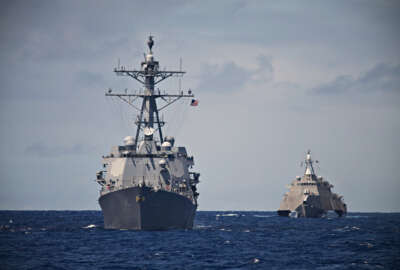Insight by Splunk
DoD Cloud Exchange 2023: Splunk’s Juliana Vida on overcoming cultural barriers to transformation
As a former Navy IT leader and helicopter pilot, Splunk’s Juliana Vida well knows the hurdles to change at DoD. During the DoD Cloud Exchange, she shares thou...
The Defense Department sees data analytics and automation as key components of an its information technology modernization journey — with the goal of greater resilience in the face of emerging threats.
“Focusing on the data and making incremental changes to keep up with the technology enhancements is really the only way the department is going to get there,” Juliana Vida, group vice president and chief strategy advisor for public sector at Splunk, said during Federal News Network’s DoD Cloud Exchange 2023.
She added that building up capacity to make data-driven decisions will be critical as well if DoD wants to become a more resilient agency.
“The time for a large organization to make a decision that actually has implementations on a battlefield, it’s too long,” Vida said. “The command and control, the organization mechanisms that are in place, do not permit warfighters — soldiers, sailors, airmen on the tactical edge — to use stuff that they need today.”
Automation can help DoD make near-real time use of its data to drive policy decisions, but she said the agency needs better input from its frontline workforce to understand what processes it should automate.
“Automation doesn’t help if we just automate bad processes that are in place. No one needs to replicate the inefficient manual systems of the legacy technology of the past,” Vida said. “Talk about how it can take away the stuff that they don’t enjoy doing and open up opportunities for them to do the fun stuff that might appeal to more people — rather than just saying ‘automation’ over and over, and people not knowing what that is.”
Why to engage the broad DoD workforce
To get the DoD workforce engaged in IT transformation, she suggested that leadership talk about automation in terms that nontechnical personnel can understand.
“Technology is so critical to the entire enterprise of DoD. There is really no reason to leave anybody out because they’re just going to keep you from making progress if you don’t bring them along and educate them,” Vida said. “Let’s talk about it in terms that people can understand, that make their lives easier and their jobs more fun. And, boom, we get more automation across the department.”
Vida said DoD leadership should talk about opportunities for automation as a way for its personnel to do their jobs better, faster, more efficiently. She added that the vision and value of IT transformation has to be communicated from all levels of leadership.
“It has to be spoken by leaders at all levels. Not just the IT leaders — not just the chief information officer, not just the chief technology officer — but the human resources folks, the finance people, the recruiting people. It has to become part of the DNA,” she said. “You don’t see people that aren’t in the Office of the CIO or maybe the chief technology officer or the chief data officer. You don’t see them out there learning about technology or how they can be part of the solution.”
While DoD leads its IT transformation efforts through policy and workforce transformation, Vida urged the department to also work with industry partners to make the most effective use of the technology that the department buys.
“Once we’ve proven ourselves, then on the DoD side that should be an open door to ‘OK, now let’s have a conversation about getting the most value,’ ” she said.
That partnership between government and industry is critical to the successful implementation of zero trust. “It’s a complete reversal of how the department has thought about technology partnership in the past. In the past, it’s been, ‘DoD will build most of it, and then sprinkle in technology.’ It’s got to be the other way because there’s too many components of zero trust to make it an easy-button solution for DoD to come up with and to build on their own,” Vida said.
How to break down barriers to change
When it comes to breaking down the siloes that prevent data sharing and IT transformation more broadly, she said department leaders needs to consider change management from the perspective of the workforce.
“I always like to start with the people and cultural barriers because the technology is generally not the problem,” Vida said. “The people and process standpoint, that’s the biggest barrier. The department has got to modernize its thinking about what a workforce looks like.”
That broadening of the DoD workforce includes opening up nontraditional pathways for individuals to join its ranks, prioritizing skills-based and real-world experience over professional credentials and college degrees.
“If the department did one thing — if it were that thing to unlock the potential of the workforce of tomorrow — I think that could get them leaps and bounds ahead of where they are today, and then they’d be able to actually leverage and get value out of the technology that they’re investing in,” Vida said.
DoD will only attract the workforce needed to make IT transformation successful if they provide the tools to make that change possible, she added.
“People want to do work that’s meaningful. They go into public service wanting to make a difference. … It’s not easy enough for people to do that,” Vida said. “They still have to use the technology that they use at home on their laptop, or on their smartphone, and then literally leave that in the car or at home, and then go to work and use legacy technology. And let’s face it, it’s just not fun for people.”
Vida recommended that DoD encourage its workforce to experiment and innovate with the tech tools available to them — and then “automate that innovation.”
“No end state of resilience is going to happen unless the department’s just smarter about leveraging the technology and becoming a more modern organization.”
To read or watch other sessions on demand, go to our 2023 DoD Cloud Exchange event page.
Copyright © 2024 Federal News Network. All rights reserved. This website is not intended for users located within the European Economic Area.
Related Stories
Featured speakers
-

Juliana Vida
Group Vice President and Chief Strategy Advisor, Public Sector, Splunk
-

Jory Heckman
Reporter, Federal News Network
On DoD
Upcoming Events
Related Stories
Top Stories

Juliana Vida
Group Vice President and Chief Strategy Advisor, Public Sector, Splunk
Juliana Vida is the Chief Technical Advisor – Public Sector at Splunk. In this technology evangelist role she provides executive-level thought leadership around the Splunk Data Platform. Prior to Splunk, she advised federal government CIOs and IT senior leaders at Gartner. She’s a retired US Naval Officer who served honorably for 24 years as a combatant ship driver and decorated helicopter pilot. Her Navy career culminated in serving as the Navy’s Deputy CIO in the Pentagon.

Jory Heckman
Reporter, Federal News Network
Jory Heckman has been a reporter at Federal News Network since January 2018. Jory got his start as an intern in 2011 and was a digital news writer and editor for Federal News Network from 2014 to 2018. He also worked as a desk assistant with CBS News Radio in New York and was a reporter for the Citizens’ Voice newspaper in Wilkes-Barre, Pennsylvania.







